|
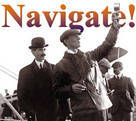
 Up
Up 
 Making the
Making the
Aerodrome
Airworthy

(You are here.)
 Down
Down




  Need
to Need
to
find your
bearings?
Try
these
navigation aids:
If
this is your first
visit, please stop by:
Something
to share?
Please:



|
|
Available in Française, Español, Português, Deutsch, Россию,
中文,
日本, and others.
 n
Hammondsport, Curtiss’ workmen had been working exclusively on the “America,”
a flying boat designed to make a record-setting flight across the
Atlantic Ocean. Curtiss had them set this aside and everyone
concentrated on the Aerodrome. Charles Manly, who had built the
Aerodrome engine, joined the team along with Albert Zahm, who was
the Smithsonian’s on-site representative. They briefly discussed
building a copy of the original catapult Langley had used in 1903,
but decided it would save effort to launch the Aerodrome from
pontoons. The team struggled mightily to get the Aerodrome ready on
time, but was plagued by unanticipated problems. The airframe was
much weaker than expected and had to be strengthened. In addition to
replacing the ribs and adding spars, Curtiss extended the outriggers
that mounted the pontoons, adding wire rigging between the
outriggers and the wing spars much the same way the upper and lower
wings of a biplane are rigged. This created a trusswork that braced
the wings for about a third of their length. n
Hammondsport, Curtiss’ workmen had been working exclusively on the “America,”
a flying boat designed to make a record-setting flight across the
Atlantic Ocean. Curtiss had them set this aside and everyone
concentrated on the Aerodrome. Charles Manly, who had built the
Aerodrome engine, joined the team along with Albert Zahm, who was
the Smithsonian’s on-site representative. They briefly discussed
building a copy of the original catapult Langley had used in 1903,
but decided it would save effort to launch the Aerodrome from
pontoons. The team struggled mightily to get the Aerodrome ready on
time, but was plagued by unanticipated problems. The airframe was
much weaker than expected and had to be strengthened. In addition to
replacing the ribs and adding spars, Curtiss extended the outriggers
that mounted the pontoons, adding wire rigging between the
outriggers and the wing spars much the same way the upper and lower
wings of a biplane are rigged. This created a trusswork that braced
the wings for about a third of their length.
The old Manly-Balzer
engine would not operate properly and the propellers did not produce
enough thrust. Curtiss replaced the original dry-cell battery
ignition with a high-tension magneto, and the primitive box-shaped
drip carburetor with a modern float-regulated carburetor. Still the
engine would not produce the necessary RPMs, so Curtiss trimmed the
propellers to give them a more modern shape with less drag.
The original
controls were two small wheel-cranks beside the pilot’s seat. The
forward wheel moved the "steering rudder" beneath the aircraft left
and right for yaw control; the rear wheel moved the Penaud tail up
and down for pitch. There was no roll control; Langely had depended
on a pronounced dihedral angle between the wings to provide roll
stability. These controls could not possibly respond in time to what
Curtiss knew to be the demands of aviation, so he replaced them with
a standard Curtiss wheel, post, and yoke. He linked the rudder to
the yoke at first, and then switched to the wheel. The tail was
linked to the control post. Eventually, he locked the rudder in
place and modified the Aerodrome’s Penaud tail to move side to side
as well as up and down.
By the time
Curtiss had worked out these solutions, Langley Day had come and
gone. He was not confident enough to attempt his first mission – to
show that the Aerodrome might have flown in 1903 – until late May.
By this time the Aerodrome was no longer the same aircraft it had
been in 1903; even a casual comparison of photos that Brewer and
others took in June 1914 with those taken of Aerodrome in 1903 shows
this to be the case. (Compare the 1903 and 1914 Aerodrome drawings
HERE.)
But Curtiss, Walcott, and the Hammondsport team would say that it
was close enough, some of them until they day they died.
Curtiss made a
few straight-ahead hops on May 28, June 2 and June 5, none lasting
more than a few seconds. These were not the results he and Walcott
had hoped for, but the media had their story and the photos to
support it. Walcott was quick to press the political advantage.
Within a week – 11 June 1914 – and while these news stories were
still fresh in the minds of legislators, House Minority Leader James
R. Mann of Illinois read into the Congressional record the results
of the Hammondsport trials. He then asserted the need to “provide
under some scientific bureau of the Government some means for
further investigations and experiments with regard to
heavier-than-air Machines.” Mann intimated that this “scientific
bureau” should be under the direction of the Smithsonian
Institution, as suggested by its Secretary. He also mentioned a
dollar amount, “…$50,000 to continue investigations along the line
of aeronautics under the Smithsonian Institution.” Nothing was
decided, but the point was made.
As for Curtiss,
he set the Aerodrome aside for a few weeks while he ramped up the
America project again, and then began the second part of his
mission – to see what value, if any, the tandem wing configuration
might have for modern aeronautics. The tests continued, albeit at a
more leisurely rate and under new management. When he was certain
the America was back on track, Curtiss bowed out and went to
Buffalo, New York to set up a new factory. Albert Zahm took over the
testing of the Aerodrome.
It was apparent
to all who attended the initial test flights that the original
Manly-Balzer engine didn’t have the oomph to get the Aerodrome in
the air and keep it there. Among the first things that Zahm and his
crew did was swap out the old radial for a new Curtiss 80 hp V-8.
They also scrapped the twin pusher propellers and replaced them with
a single tractor screw. Flights resumed in September of 1914 and the
Aerodrome performed much better. Curtiss pilot Gink Doherty was able
to keep the machine aloft for distances up to half a mile, reaching
an altitude of 30 feet. And the machine continued to evolve. Zahm
and crew experimented with its center of gravity, control linkages,
the diameter and pitch of the propeller, number and position of the
pontoons, the length of the secondary spars, and a dozen other
details. In March 1915 while Lake Keuka was still frozen, they
swapped the pontoons for skates, reducing weight and drag.
Eventually they were able to fly 20 miles – the length of the lake.
But throughout all this experimentation, the Curtiss team was never
able to navigate the Aerodrome. Of the three pilots who eventually
flew the aircraft – Glenn Curtiss, Elwood Doherty, and Walter
Johnson. – none ever made a successful turn of more than a few
degrees.
In early June of
1915, Orville’s brother Lorin visited Hammondsport under an assumed
name and observed several Aerodrome flights before he was found out.
As luck would have it, he witnessed a flight in which the rear A-frame
that supported the wing rigging were swapped out for something
approaching the original
guy post. The back wings collapsed in flight, just as they had
during a launch attempt in 1903. The photographs he took were
confiscated, but he was able to note this change and many others
that had been made to the Aerodrome up to that time. And there were
probably more changes after that. The flight tests continued until
November 1915 when Curtiss called a halt. The Aerodrome was
disassembled, packed up, and returned to the Smithsonian.
|
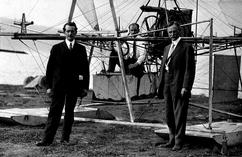
Left to right: Charles Manly, Glenn Curtiss, and Albert Zahm with
the rebuilt airframe of the Aerodrome.
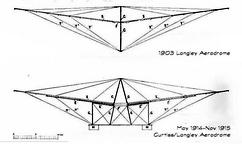
These drawings by Griffith Brewer show the rigging of the original
Aerodrome and the rigging of rebuilt Aerodrome that was flown by
Curtiss.
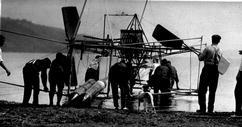
This "taxi test" (without wings) on 27 May 1914, clearly shows the extensions to
the airframe that helped brace the wings.
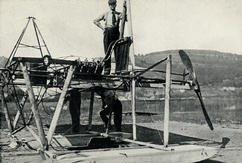
After the June 1914 flights, the original Aerodrome engine and
pusher propellers were replace with an 80 hp Curtiss motor turning a
single tractor airscrew.
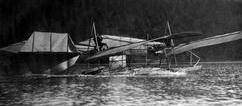
The Aerodrome on a take-off run on September 17, 1914 with a new
engine and propeller. Note the tail dragging in the water. The tail
was later raised not only to keep it from getting wet but also to
give it greater freedom of movement.
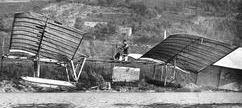
The position of the pilot was also changed. Note that the shoulder
yoke has been removed, the pilot is using just the wheel and the
post to steer the aircraft. In all, three pilots flew the modified
Aerodrome – Glenn Curtiss, Elwood "Gink" Doherty (shown), and
Walter Johnson.
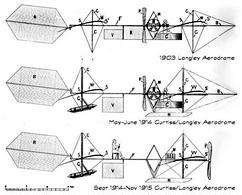
Top: The original configuration of the Aerodrome. Middle: The
aircraft during the first phase of the Hammondsport tests when
Curtiss and Walcott were trying to show that the "original"
Aerodrome was airworthy. Bottom: The aircraft during the second
phase when the "tandem configuration" was tested.
|